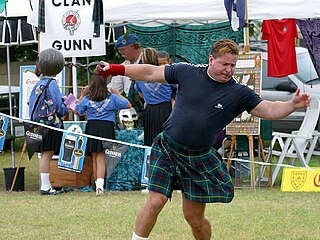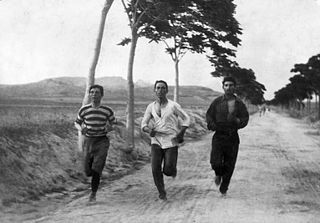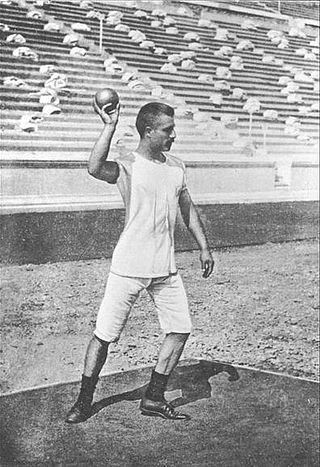
Track and field is a sport that includes athletic contests based on running, jumping, and throwing skills. The name is derived from where the sport takes place, a running track and a grass field for the throwing and some of the jumping events. Track and field is categorized under the umbrella sport of athletics, which also includes road running, cross country running and racewalking. In British English the term "Athletics" is synonymous with American "Track and Field" and includes all jumping events.

Two sports have events that fall under the name of weight throw one being the track and field event and the other being the Scottish highland games events.

The men's shot put was a track and field athletics event held as part of the Athletics at the 1904 Summer Olympics programme. It was the third time the event was held. The competition was held on August 31, 1904. 8 athletes from 2 nations competed. The event was won by Ralph Rose of the United States, the nation's third consecutive victory in the men's shot put. Americans won silver and bronze as well, completing the second consecutive podium sweep in the event.

The men's 56 pound weight throw was a track and field athletics event held as part of the Athletics at the 1904 Summer Olympics programme. It was the first time the event was held. It would not appear on the Olympic program again until the 1920 Summer Olympics, which would be the last time the 56 pound weight was thrown in the Olympic Games. The competition was held on September 1, 1904. 6 athletes from 2 nations competed. The event was won by Étienne Desmarteau of Canada, one of only two gold medals in athletics won by an athlete not from the United States. Americans John Flanagan and James Mitchel took second and third, respectively.
The men's 56 pound weight throw event was part of the track and field athletics programme at the 1920 Summer Olympics. It was the second appearance of this event after the debut in 1904. The Intercalated Games in 1906 saw a stone throw event. The competition was held on Friday, August 20, 1920, and on Saturday, August 21, 1920.

The 400 metres at the Summer Olympics has been contested since the first edition of the multi-sport event. The men's 400 m has been present on the Olympic athletics programme since 1896 but nearly seventy years passed before the introduction of the women's 400 m, which has been held continuously since the 1964 Games. It is the most prestigious 400 m race at elite level. The competition format typically has two qualifying rounds leading to a final race between eight athletes.

The 800 metres at the Summer Olympics has been contested since the first edition of the multi-sport event. The men's 800 m has been present on the Olympic athletics programme since 1896. The women's event was first held in 1928, making it the first distance running event for women. However it was not held again until 1960, since when it has been a permanent fixture. It is the most prestigious 800 m race at elite level. The competition format typically has three rounds: a qualifying round, semi-final stage, and a final between eight runners.

The marathon at the Summer Olympics is the only road running event held at the multi-sport event. The men's marathon has been present on the Olympic athletics programme since the first modern Olympics in 1896. Nearly ninety years later, the women's event was added to the programme at the 1984 Olympics in Los Angeles.

Team races at the Summer Olympics were track running competitions contested at the multi-sport event from 1900 to 1924.

The 60 metres at the Summer Olympics was contested at the multi-sport event in 1900 and 1904. Part of the Olympic athletics programme, it is the shortest sprinting event to have featured at the Olympics. The shortest sprinting event on the current programme is the 100 metres. Only men competed in the two years that the event was held.

The shot put at the Summer Olympics is one of four track and field throwing events held at the multi-sport event. The men's shot put has been present on the Olympic athletics programme since 1896. The women's event was added to the programme at the 1948 Olympics just over fifty years later.

The discus throw is one of four track and field throwing events held at the Summer Olympics. The men's discus throw has been present on the Olympic athletics programme since 1896. The women's event was first contested at the 1928 Olympics, being one of the five athletics events in the inaugural Olympic women's programme.

The hammer throw at the Summer Olympics is one of four track and field throwing events held at the multi-sport event. The men's hammer throw has been present on the Olympic athletics programme since 1900, becoming the third Olympic throws event after the shot put and discus throw. The women's event was a much later addition, being first contested at the 2000 Olympics.

The javelin throw at the Summer Olympics is one of four track and field throwing events held at the multi-sport event. The men's javelin throw has been present on the Olympic athletics programme since 1908, being the last of the current throwing events to feature at the Olympics after the shot put, discus throw and hammer throw. The women's event was first contested at the 1932 Olympics, becoming the second women's throws event after the discus in 1928.

The pole vault at the Summer Olympics is grouped among the four track and field jumping events held at the multi-sport event. The men's pole vault has been present on the Olympic athletics programme since the first Summer Olympics in 1896. The women's event is one of the latest additions to the programme, first being contested at the 2000 Summer Olympics – along with the addition of the hammer throw, this brought the women's field event programme to parity with the men's.

The high jump at the Summer Olympics is grouped among the four track and field jumping events held at the multi-sport event. The men's high jump has been present on the Olympic athletics programme since the first Summer Olympics in 1896. The women's high jump was one of five events to feature on the first women's athletics programme in 1928, and it was the only jumping event available to women until 1948, when the long jump was permitted.

The long jump at the Summer Olympics is grouped among the four track and field jumping events held at the multi-sport event. The men's long jump has been present on the Olympic athletics programme since the first Summer Olympics in 1896. The women's long jump was introduced over fifty years later in 1948 and was the second Olympic jumping event for women after the high jump, which was added in 1928.

The triple jump at the Summer Olympics is grouped among the four track and field jumping events held at the multi-sport event. The men's triple jump has been present on the Olympic athletics programme since the first Summer Olympics in 1896. The women's triple jump is one of the more recent additions to the programme, having been first contested in 1996. It became the third Olympic jumping event for women after the high jump and long jump.

Combined events at the Summer Olympics have been contested in several formats at the multi-sport event. There are two combined track and field events in the current Olympic athletics programme: a men's decathlon and a women's heptathlon.

In the sport of athletics, pentathlons have taken various forms over the history of the sport, typically incorporating five track and field events. The only version of the event to remain at a high level of contemporary competition is the women's indoor pentathlon, which is present on the programme for the World Athletics Indoor Championships.


















